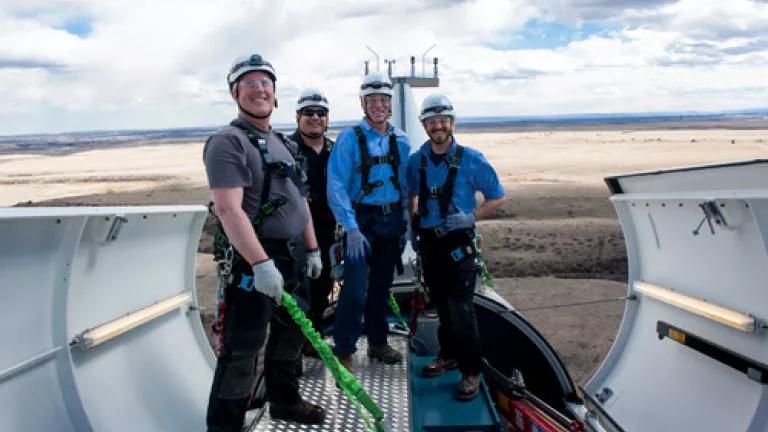
Colorado Senator Mark Udall and the National Renewable Energy Lab Director on top of a windmill. Source: Dennis Schroeder/NREL
On Monday, the Environmental Protection Agency (EPA) followed through on President Obama’s commitment to limit carbon pollution from power plants. The proposed standard sets targets for each state, based on the local energy resources and profile. In Colorado, the standard requires a 35% reduction in the carbon intensity of emissions from the 2012 level by 2030. (Carbon intensity is a measure of the amount of carbon produced per the amount of electricity generated.)
As one of the nation’s leaders in clean energy, Colorado already is well on its way to exceeding the EPA’s proposed carbon pollution reduction targets.
Even before the proposed rules were announced this week, Colorado utilities were using renewable resources like wind and solar to make electricity faster than required by state law. The results? Cleaner air; more homegrown clean energy jobs; and a faster growing economy.
The standard’s building blocks
As my colleague Dave Hawkins explains in more depth, EPA’s proposed standards – the nation’s first to cut the carbon pollution from existing power plants -- were tailored for each state based on its energy profile.
The agency set the targets by using modest estimates of what each state could accomplish through four building blocks. (States need not use these building blocks to comply with the standard, and NRDC’s analysis shows that states can meet the standards through use of energy efficiency and renewables, without using more fossil fuel.)
1) Making coal plants more energy efficient;
2) More effective use of natural gas plants that already exist or are under construction to displace coal burning;
3) Increasing renewable energy at the region’s current average growth rate for the amount of renewable sources like wind and solar used to generate electricity (but capped at the average of all the renewable standards of states in the same region) and counting 6% of the nuclear energy generated in the state;
4) Slowly ramping up the amount of energy efficiency savings obtained through utility programs like weatherization and rebates for upgraded appliances by 1.5% a year. When customers waste less energy, their bills go down and power plants don’t have to use as many dirty resources to make electricity, which also reduces the emissions warming our planet and harming our health.
Colorado’s clean energy leadership is paying off
We already know that Colorado’s current trends and policies will outpace the numbers in EPA assumptions in steps 2, 3 and 4: Here’s why:
First, low gas prices and Colorado’s Clean Air Clean Jobs law mean Colorado is shifting away from dirty coal and using more natural gas- which reduces power plant carbon emissions at the stack. Unfortunately, gas development also comes with a wide range of other public health and environmental threats that many Colorado families are all too familiar with. Given these impacts—in addition to safeguarding against them as much as possible—the state would be wise to prioritize maximizing its investments in wind, solar and efficiency as a means of complying with the federal standards.
Fortunately, Colorado is well on its way in ramping up its use of clean energy, leading to lower emissions and greater consumer benefits:
Renewable energy: Colorado’s renewable portfolio standard requires investor-owned utilities to use 30% renewables to generate power by 2020 (rural coops, which serve far fewer customers, will meet 20%). And Colorado utilities have recently gone above and beyond the 30% required under the renewable standard, buying wind and solar power because they are the cheapest resources.
In setting Colorado’s target, EPA assumes the state’s renewable power resources will grow much more slowly than in recent years and stop altogether at 21% of the total fuel mix to generate electricity in the state (based on a regional average)! Renewable price trends, and Colorado’s current law, mean that EPA’s assumption isn’t just modest, it’s excessively conservative. Renewable energy is growing far faster, and providing more benefits, than EPA contemplated. Since renewable energy produces no pollution, this assumption means EPA is significantly underestimating what Colorado will do to cut carbon dioxide pollution --and the health and other benefits it will achieve.
Energy Efficiency: EPA’s proposed standard for Colorado assumes very slow energy efficiency deployment. But Colorado utility investments in energy-saving programs are already reducing electricity use by nearly 1% a year. At a modest growth rate of a quarter percent per year, Colorado could double that by 2020. At that rate, Colorado could achieve cumulative savings, and emissions reductions about twice what EPA assumes is possible.
Because of Colorado’s leadership on clean energy the state will easily meet and exceed EPA’s proposed target by simply maintaining current momentum on cutting emissions. Doing so will continue to grow Colorado’s clean energy economy and improve public health.
This also shows that EPA could not only deepen the savings, but also expand all the benefits of the proposed standard by going even further to maximize efficiency and renewables. These are the clean energy sources that can provide a better future for the children of Colorado and across the country.
